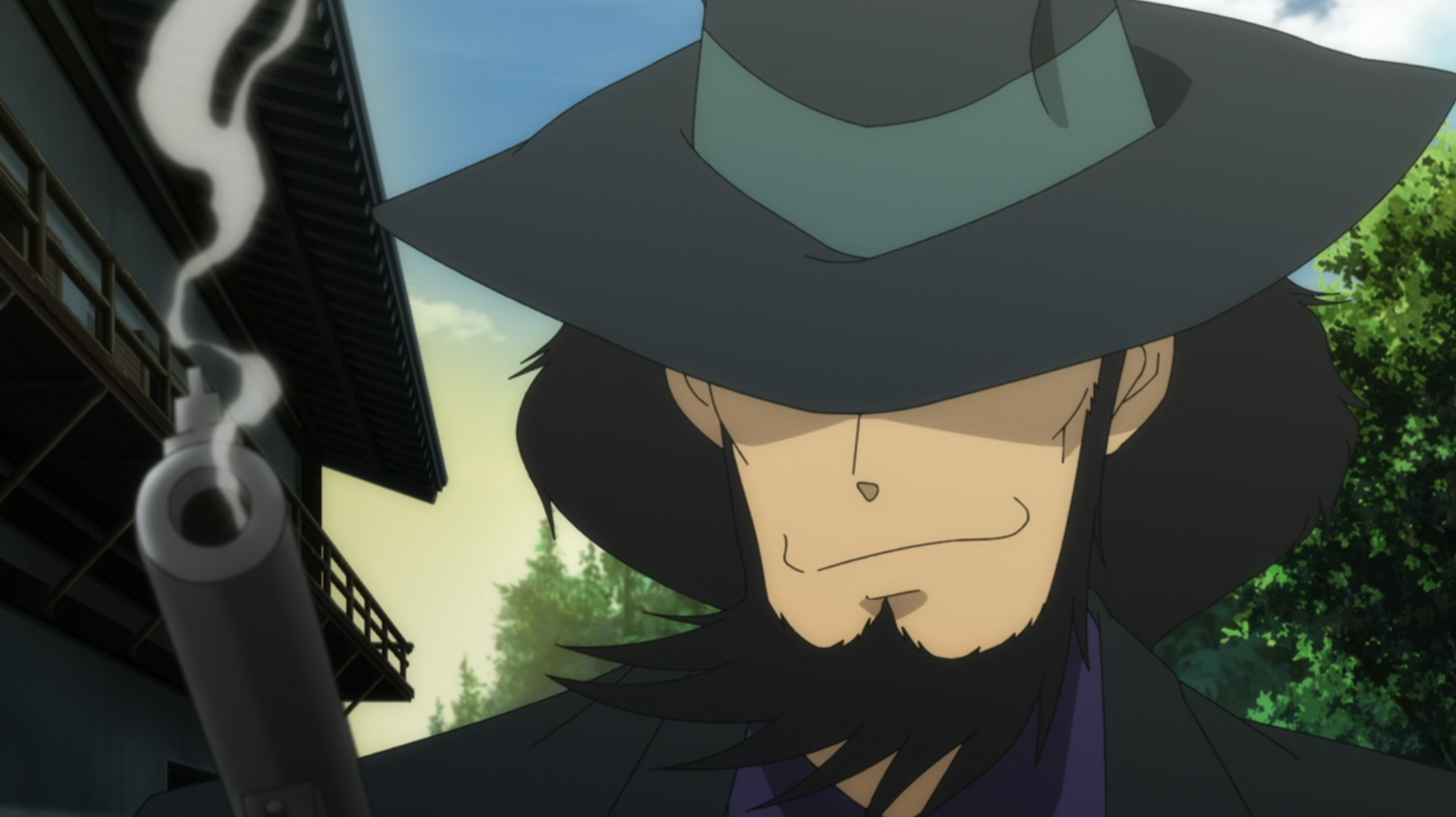You're a Good Man, Daisuke Jigen
Episode Reviews & Overviews by TabbieWolf
According to the Castle of Cagliostro character guide, November 29th was Daisuke Jigen’s birthday! So in honor of the day, here are some of the best episodes featuring Jigen in the spotlight:
Part 2, Episode 58: “The Face of Goodbye at the National Border”
Also known as: “Gettin’ Jigen With It” (Geneon Dub)
Jigen goes through several romances — and remembrances of romances — in Part 2, and this is one of those episodes! A famous Russian ballerina marries Jigen so she can cross the border and get citizenship elsewhere.
This episode was written by Yutaka Kaneko, who has written a TON of Lupin III — ranging from ridiculous “Tutankhamen's 3000-Year Curse” to “The Target Is 555 Meters” in Part 2, as well as another fantastic Jigen-themed episode, “I Saw the Kindness of a Man's Heart in Jigen.” He also wrote episodes for Part 3 that will be explored later in this article!
Kaneko is also responsible for scripting the cancelled Lupin VIII pilot, which eventually found its way to American television screens by becoming Inspector Gadget, but that’s an entirely different rabbit hole.
This is a fantastic episode, and I personally am especially partial to the English dub (Jigen’s dub actor, Richard Epcar, has said it’s one of his favorite episodes). It definitely shows that the tough, cool gunman has a heart of gold.
Part 2, Episode 99: “The Combat Magnum Scattered in the Wasteland”
Also Known As “Fighting Jigen” (Crunchyroll) “The Scattered Magnum” (Discotek)
(No English dub for this one)
Lupin is on the quest for a vast treasure when one of Jigen’s old rivals pops up, looking for revenge for past misdeeds. How will the world’s best gunman fair in a race against time and against his partner’s really assumptive choices?
Originally premiering on September 3, 1979, episode 99 was the first anime to ever be broadcast in stereo — something we don’t even pay attention to these days, considering the specialty sound systems built into modern televisions! This episode is also one of the few from this season of Part 2 that had sound effects in the title sequence, really showing off the stereo sound.
This is (entirely the author’s opinion, mind you), one of the best episodes of Lupin III in the entire series. The animation is brilliant — done by Telecom Animation Film, the same folks who were working on Castle of Cagliostro (many who would go on to work for Hayao Miyazaki’s Studio Ghibli), and rumored to have been poked through by Yasuo Otsuka (the man who did the character designs for Part 1, and the owner of the Fiat 500 that eventually made its way into becoming Lupin’s main mode of transportation) himself — with intricate painted backgrounds and fantastic action sequences.
The writing is stellar, as well, giving all of the members of the gang — including Zenigata! — time to shine. The writer of the episode, Atsushi Yamatoya, worked from one of the original issues of the manga. “Spaghetti Jigen/Western Jigen,” part of the New Lupin III series that was being published in Weekly Manga Action when Part 2 was airing. Though the story was changed for the anime, bringing in Lupin’s gang instead of the one-off Woman of the Week that often featured in the manga, there are some parts that are almost shot-for-shot the same!
(From the TokyoPop English translation)
Atsushi Yamatoya, outside of writing this utterly amazing episode, also wrote for Parts 1 and 3 of Lupin, as well as other episodes of Part 2 (including the Nessie episode, and another Jigen-focused episode: “The Rose and the Pistol/Shot Through the Heart.” He also was helped with the series composition from episode 53 onward), and Legend of the Gold of Babylon! However, he wasn’t best known for his work in anime, even though Lupin III wasn’t the only anime series he worked on (others included “Ashita No Joe 2” and “Cat’s Eye”). He was actually more known for writing and directing pink films.
Pink films are, uh. Well. Pornography! And wow, he worked on a lot of them, including Banned Book: Flesh Futon, Secret Hot Spring Resort: Starfish at Night, Inflatable Sex Doll of the Wastelands, and Naked Seven (the pornographic satire of Akira Kurosawa’s Seven Samurai). He certainly had quite a scope for his writing abilities!
Part 3, Episodes 27 & 28: “Codename: ‘Star of Alaska’” & “The ‘Star of Alaska’ is a One-Way Ticket to Hell”
(No English dub for this one)
Lupin wants to get a special engagement ring for Fujiko, but the ring has a secret — and a link to Jigen’s past! This two-parter has it all: action, drama, romance, comedy, helicopters, disguises, Lupin in a robot suit! For some reason!
Yutaka Kaneko, writer of the first episode mentioned, also wrote these two — writers who like Jigen seem to *really* like him as a character. And, like Atsushi Yamatoya, Yutaka Kaneko was known for his work in pink films (under a pseudonym) and television drama, including a lot of work in detective shows. These two episodes definitely follow a similar pace!
To the detective shows. Not the porn.
Probably.
Part 4, Episode 4: “With A Gun in my Hand”
(English Dub Available)
Part 4 took a different direction than the previous Lupin series: it had a running storyline, with two overarching plots (called “cours” in anime lingo) that linked together, following the more usual method for storytelling in anime compared to the “each episode is its own little story” method of Parts 1, 2, and 3. It had a few “filler” episodes — episodes that linked only to the main story by way of having the same characters and being in the same location, but not being involved in the main plot — and this one is Jigen’s!
“Damn tooth throbs these days. Happens whenever I get jumpy. Gettin' too old for this crap!”
A running character trait in the series, starting with the first episode of Part 2, is Jigen’s tendency to have toothaches. One hits him here, and he goes to the local medical clinic to get some help. There, he discovers the town has an interesting underbelly, and it’s up to one super cool gunman to put a stop to it.
Not that he really wants to. But they do take his gun.
The writer for this episode was Tomohiro Suzuki, who did a few other episodes for Part 4, as well as the first twelve episodes of “One Punch Man!”
The episode was storyboarded by Kazuhide Tomonaga, who has been working on Lupin III since Part 2, and has done character design and key animation for the series ranging from theatrical releases like Castle of Cagliostro, Fuma Conspiracy, and Fujiko Mine’s Lie, to TV series like Part 5, and a whole lot inbetween! Other animes he’s worked on include Galaxy Express 999, The Wind Rises, and Castle in the Sky. For American fans, he was also an animation director for shows like “Tiny Toon Adventures” and “Animaniacs” (perhaps the reason that Jigen character design snuck into that one episode…)
Part 5, Episode 19, “A 7.62MM Mirage”
(English Dub Available)
Like Part 4, Part 5 took a more “modern anime” approach to its storytelling…and then promptly turned it on its head, mixing four story arcs — called Episodes in the series — that all linked together into one big story with fun homages to previous series and single-character-focused episodes. And of course, being our main character’s right-hand man, Daisuke Jigen got his own episode!
A LOT of Jigen’s episodes are in relation to the men and women he’s been involved with — be it for love, for work, or otherwise. The specials and movies do this as well. He doesn’t talk about his past, ever (it’s not important…except when it is), and the little peeks of it we get are always fun to explore. Part 5 focused on one completely bonkers millionaire with a desire see Lupin’s head explode (“…like a watermelon!”) and the person he hired to do such a thing being a mercenary from Jigen’s past. And being the convincing guy he is, Lupin convinced Jigen to cover his butt…and learned a bit more about his partner’s ever-mysterious past along the way.
Keiichi Sigsawa, the writer of this episode, is a gun enthusiast — according to the Part 5 art book, he brought in some of his own collection for the artists to work from.
The Woman Called Fujiko Mine, Episode 2: ".357 Magnum"
(English Dub Available)
Aright, this one is going to be a bit more difficult to summarize. “The Woman Called Fujiko Mine” is a fantastic series, but it also comes with a long list of trigger warnings because of the elements it explores. Like “Revolutionary Girl Utena” before it, it relies heavily on metaphor (both visual, in character development, and story-wise), so it crams a whole lot into its short length of 13 episodes. This particular episode includes nudity, violence, attempted suicide, suicidal ideation, non-consensual sexual advancement and touching, and character death.
Deep breath. Everyone still with me? We’re still talking about Lupin III, I swear.
This one is different, because “The Woman Called Fujiko Mine” is different. It’s a darker look at Jigen’s past, before he met that charming thief, exploring the mercenary/sniper-for-hire/mob gun we’ve heard him mention he used to be when he oh-so-rarely talks about it. Another story about a person from his past, and about the man he is and wants to be, and starts to become before he meets Lupin III.
Of the entirety of The Woman Called Fujiko Mine series, which was directed by the amazing Sayo Yamamoto (she also did “Yuri On Ice”), this is one of three episodes where she did some of the storyboards. The individual episode direction was done by Hideki Tonokatsu, who has also worked as director and/or artist on Alcatraz Connection, The Columbus Files, Missed by a Dollar, and other Lupin television specials.
Part 6, Episode 0 “The Times”
(English Dub Rumored, Not Available As Of This Posting)
It would be impossible to talk about Jigen episodes without talking about this episode. It is the defining one — a look back on 50 years of the world’s best gunman and why the heck he hangs around with an overly clever thief in a ridiculously colored jacket. It was the final episode for Jigen’s first voice actor, Kiyoshi Kobayashi, who had been voicing him since the pilot film in 1969.
It’s also sort of impossible to describe “The Times” without solidly knowing the rest of Lupin III. I mean, sure, you can: Daisuke Jigen starts to feel like he’s too old for this stuff, these new cops with their weird electronic guns, and ponders his retirement from the world of thievery and from the men and woman he’s spent his life with. But the entire episode is a love letter — to both Kiyoshi Kobayashi and to man he voiced — wrapped in a bottle of whiskey, with a couple explosions (emotional and literal) along the way. If you are new to watching Lupin III, I recommend waiting until you have seen a fair chunk of the series before watching this episode.
“The Times” was written by Yūya Takahashi, who has been working with Lupin III since Part 4, and also wrote the screenplays for Jigen’s Gravestone, Goemon’s Bloodspray, and Fujiko’s Lie.
So, raise a glass and cheers to the world’s greatest gunman! May he be with us for many, many years to come.




